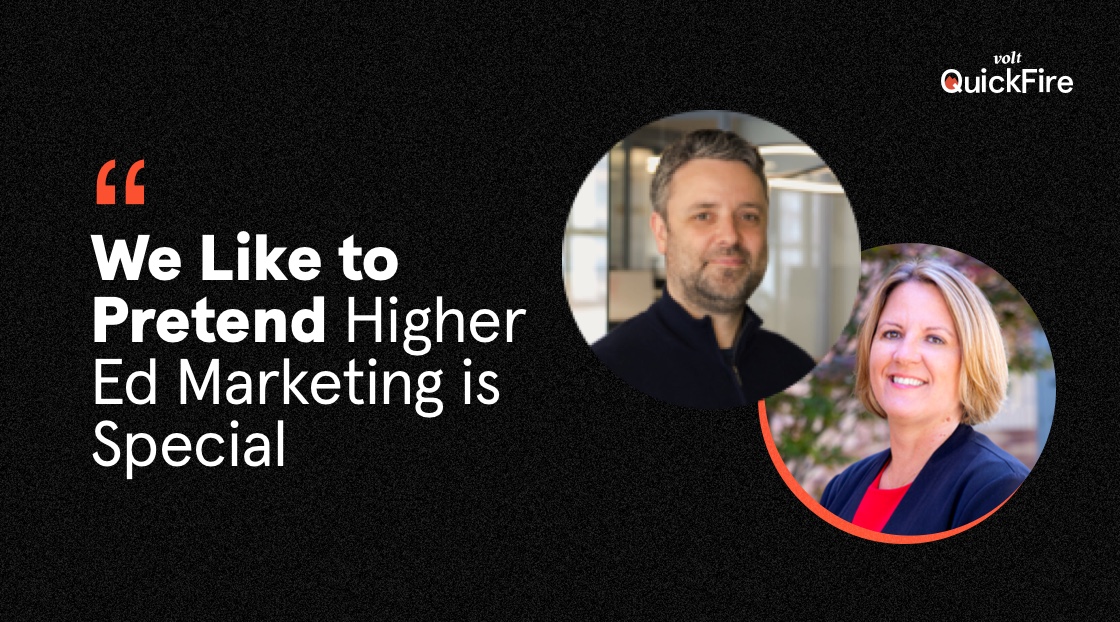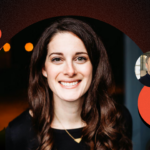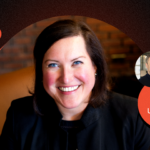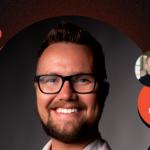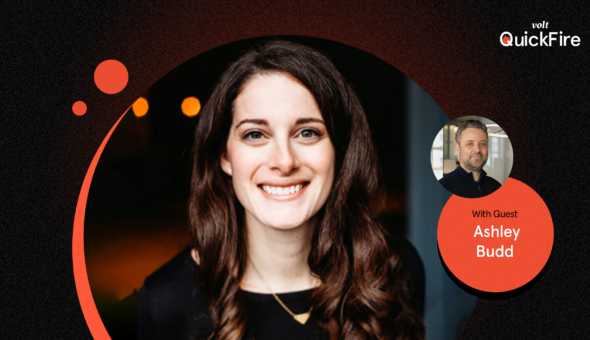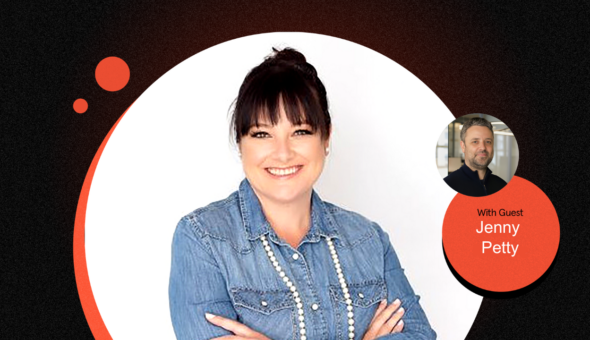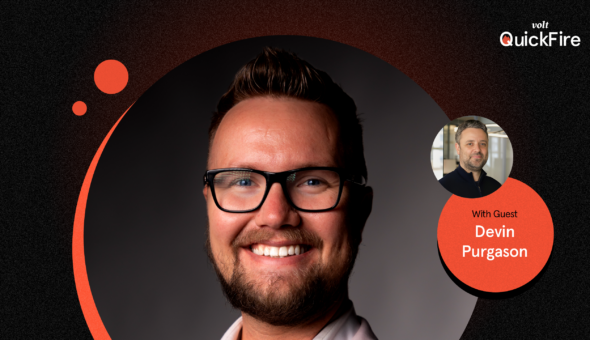Read the full transcript here
Kevin Renton:
Hi there. I’m Kevin Renton and welcome to Quickfire with Volt. This is where we get higher ed marketers and put them in the hot seat and ask them 20 rapid questions to find out what makes them tick, what makes them successful, and what their goals are for the future. In the crossfire today we have Jamie Ceman, Vice President of Strategic Marketing and Communications from Chapman University. Welcome, Jamie.
Jamie Ceman:
Thank you. Thank you for having me.
Kevin Renton:
Not at all. And to kick off, give us your elevator pitch. What do you do at Chapman University?
Jamie Ceman:
As you said, I’m the Vice President of Strategic Marketing Communications. So that role oversees marketing, communications for enrollment, marketing admissions, clearly fundraising, marketing, all the things that we do for national awareness, brand reputation management, public relations, media relations, really the gamut of marketing communications for Chapman. Chapman’s a mid-sized private university in southern California, and we really just got into the national rankings about five years ago, so a big focus of ours is brand awareness and building national reputation.
Kevin Renton:
How big is your team there?
Jamie Ceman:
35 people.
Kevin Renton:
Whoa, so you got your hands full.
Jamie Ceman:
Yeah. They’re a great team though.
Kevin Renton:
Okay. I wanted to work in higher education because…
Jamie Ceman:
I think like most people in higher ed marketing, we found this by accident. I didn’t plan, by any means, to end up in higher ed marketing, but a position opened up where I did my undergrad, and it just seemed fun at the time. And so I interviewed, and I remember still just walking to the interview thinking, ‘Oh my God, can I really just work at a campus and be in college all day every day’ and turns out you can, so here I am.
Kevin Renton:
It’s one of the really interesting things that a lot of the people that we’ve spoken to in this series, it’s the energy that you get from being on campus and you don’t forget it once you’ve been to university. And you’re right to actually go back and have that as your day-to-day is fantastic.
Jamie Ceman:
It is. It’s so fun. And having meetings about homecoming and mascots, and I still remember my first meeting with a faculty and it was an English faculty who made some obscure Great Gatsby reference. I’m like, ‘”It’s just so fun being here.”
Kevin Renton:
The marketing tool I can’t live without is ….
Jamie Ceman:
It’s sort of nerdy, but data. I am a complete data nerd. And actually just this week we had a meeting about more dashboards, and I just get giddy by it. So data informs everything I do and everything my department does, and so it’s just couldn’t live without that.
Kevin Renton:
How do you get your data? On which dashboards do you use?
Jamie Ceman:
It depends. We have a big digital presence with side vendors, so we get tons and tons of data from that. We have all kinds of different tools. Our PR team uses Cision, our social media team uses Sprout Social. So it all just depends, we just have tons of it. So what we’re trying to do now is build a more aggregated dashboard, a data warehouse and a dashboard that’ll give us the 30,000 foot on all of it. Because now it’s all these different places, so that’s what made me super nerd out this week was how do we build a data warehouse?
Kevin Renton:
Whoop whoop. My biggest professional mistake was …
Jamie Ceman:
Doing B2C retail marketing in the recession. I jumped to an e-commerce retailer at the start of the recession and I can tell you it was the stupidest mistake I’ve ever made. Most stressful time of my life. I had more stress dreams about not being able to find my locker and missing my final exam through that two years that I was in retail marketing than I’ve ever had in my life. So that was absolutely my biggest mistake.
Kevin Renton:
Were there any key takeaways from what you learned in B2C marketing that then helped you in higher ed marketing?
Jamie Ceman:
Oh, for sure. Yeah, absolutely. And we like to pretend that higher ed is sort of special, but it’s consumer marketing to a degree. And so what was great about retail marketing during the recession is that we got super efficient and effective about making the most out of everything we could because you just had to. And so I just learned so much and worked with incredibly smart people and a lot of that I could apply to higher ed marketing. Especially I learned a lot about email marketing at the time. That’s really where that got the basis of that skill set. And so of course I’ve been able to apply a lot of that in higher ed.
Kevin Renton:
Yeah, and maybe it helped that love of data as well.
Jamie Ceman:
It might be where it came from because it was so data-driven when we were there and now it’s like, I don’t know how you do marketing without that.
Kevin Renton:
When I’m not working, I’m …
Jamie Ceman:
I have a 16-year-old who plays soccer and she wants to do D1, so my whole external life is soccer tournament, soccer practices, soccer games. And soccer, soccer, soccer.
Kevin Renton:
I start my day at …
Jamie Ceman:
About 6:00 AM. Nothing too extreme, but you wake up, I grab my phone and I clear out whatever happened overnight and go on from there. It’s about 6:00 AM
Kevin Renton:
The secret to our students succeeding at my school is …
Jamie Ceman:
The thing about Chapman is we talk about the Chapman experience and there’s a certain level, I think, in need of a student to be really engaged. It’s kind of probably hard to keep to yourself on a campus like this. It’s got this sort of family feel to it that, so I think a level of engagement is probably necessary to really thrive here.
Kevin Renton:
I admire the marketing at …
Jamie Ceman:
Well, Amy Hung from Boston University will be so happy. I said this because, and I tell her every time, Boston University I have watched their marketing for just years and years and I think that they were one of the first campuses who did a really excellent job of brand consistency even down to the school and college level. And so I tell her this, I gush over her whenever I see her. So Boston University.
Kevin Renton:
What are some of the challenges with brand consistency that you’ve seen? What are some of the things that make it hard?
Jamie Ceman:
The baseline understanding for people across campus is that they’re not competing with each other, they’re competing externally. And so that brand consistency may feel boring, but it’s actually a necessity. The business school doesn’t have to differentiate itself from film school. The consistency is obviously what’s going to build brand awareness externally. So I think there’s just the sort of fundamental understanding of what brand marketing is. Then there’s also the, and I say this to my team all the time, we get bored with it too. And I think our own discipline in maintaining brand consistency is supercritical and it’s easy to get bored with it and start destroying ourselves.
Kevin Renton:
The getting bored with the brand things, you think it is because you’re living it and you’re working in it. But the external market, obviously being in Philly Temple had this brand slogan “made in Temple” and the city loved it, or it was “Temple made”, and the city loved it and the alum loved it, and of course they changed it and every year there’s the clamor of like, ‘Hey, can we just bring it back like Temple made?’
Jamie Ceman:
Right. Why did you do it? And that’s exactly what happens. You start to water it down yourself because you are just yourself, we’re creative people by nature, so we just keep pushing the boundaries.
Kevin Renton:
The biggest challenge facing higher education marketers are …
Jamie Ceman:
In general, having the resources to do the work that we need to do. And I think being even efficient with the resources that you have. It’s easy to say that I don’t have enough people, I don’t have enough money, but I think that it’s harder for us to look at whether am I doing the right things with the resources that I have. And I think that’s the first thing people need to be looking at instead of creating the reasons why I can’t do these things. What can I be doing differently so that I can get these things done? I think is something I’ve long seen I think in the industry of, especially because there is, and I came from a public higher ed, and I really did not have the resources needed to really do what we needed to do. And so how do you get super pragmatic about what do we do with our limited resources as compared to what we don’t?
Kevin Renton:
My favorite social media channel is … And why?
Jamie Ceman:
I mean personally, it’s LinkedIn. I’m sort of a LinkedIn junkie. I think that’s great for networking, I think it’s great for education. And even for our institutional marketing, it’s really good for rank and reputation work that we do. My social media team would not say LinkedIn is their favorite channel, but it’s fine.
Kevin Renton:
My biggest professional achievement is …
Jamie Ceman:
Just this past year certainly it was sort of a big career milestone that my internal team did a brand refresh. I’ve historically done that with an agency and it was the first time I’ve actually been able to run one completely in-house and to have the team to be able to do it, to have the level of creativity that we needed to do it, and then the expertise to not just build it but roll it out, that was an absolute career milestone for me this past year.
Kevin Renton:
Yeah. It’s fantastic and great. And you’re right, I almost think that brand refreshes, it’s all about, sometimes it’s about the people and if you can bring the people along in that journey and do it in-house, the amplification of the activation of it actually is then easier or sometimes more impactful.
Jamie Ceman:
Well, it feels so much more authentic because instead of trying to have an external agency understand who we are, we understand who we are, and now to be able to have the talent to be able to articulate it. It’s the absolute strongest brand I’ve ever worked on and it’s being so well received and people look at it now and they’re like, ‘yep, that’s absolutely Chapman’. So it was a pretty incredible year.
Kevin Renton:
What’s working in higher ed right now?
Jamie Ceman:
I think in a broad sense, I think that schools are becoming more nimble in understanding what they need to do to respond to external forces. I think that there are better conversations about programs and curriculum development and certainly how we’re using marketing to advance the institution. I think that that’s going relatively well now. And again, the external forces are kind of making that happen, but I think higher ed is getting a little bit better about responding to it.
Kevin Renton:
And the opposite, what’s not working in higher ed right now?
Jamie Ceman:
Well we all know there’s this growing narrative about the value of higher ed, and I think that there are so many conversations amongst higher ed professionals about how to tackle that, and so many of the solutions seem to be, we talk to each other about the things that we know are great about higher ed. I don’t think that we’ve found a really effective way to change the minds of the people who don’t have the confidence in us. So I do think there’s a lot of work to do for our industry to really show our value.
Kevin Renton:
The future of higher education will be …
Jamie Ceman:
It’s a big philosophical question because there’s so much happening, especially with enrollment declines that are really going to start to hit in the next few years and schools are starting to shut down who haven’t been able to weather it up to this point, and it’s only going to get worse. I think that there’s a lot of conversation about the humanities and the death of the humanities, and we’re watching it play out in different schools. We’re cutting these programs. I think that for me, it’s not are we cutting the humanities, but should institutions be looking at whether or not they need to be all things for all people and maybe that institutions might be able to survive if they learn how to specialize a little bit more. That maybe I don’t go to this particular school because they don’t have the English major anymore, philosophy major anymore. But this school over here has an amazing philosophy department, let them succeed in that and we’ll succeed in what we can. I think the level of specialization is going to have to start to happen if some of these campuses want to weather this.
Kevin Renton:
A key to my success has been …
Jamie Ceman:
I’ve always been sort of maybe, and this sounds maybe arrogant and I don’t mean it to be, strategic to a fault. I think it’s really hard, I struggle with anyone who wants to do anything that they can’t anchor it to some sort of a strategy. I think it’s helped us, helped me stop chasing after shiny objects. I think it’s allowed me to be pretty methodical in how I lead this department for us to stay really focused on here’s our priorities, here’s what we’re going to do to accomplish them. If you want to do something, what priority does it anchor to? Otherwise, it’s just not worth our resources.
Kevin Renton:
What part of your career did you penny-drop that chasing shiny objects wasn’t going to work? Because you can’t help it, I think, at some point in your career where whether it’s virtual reality or whether it’s like this would be a great marketing tool or augmented reality or whatever, or campus tours online or all the things where it’s like the shiny objects always appear.
Jamie Ceman:
I know. And I think there was a point at which that started to accelerate and we all started chasing them. And at some point you just realized, I chased this thing, this new social media platform named the one that’s died since, and we put resources into it and it didn’t go anywhere. And so I think just organically over time, everybody kind of started to realize this needs to be a little more established before I put real time and energy into it. And putting my focus into the real things that we do. A couple of years ago, actually it’s probably been almost five years ago, I started using a maturity model and that actually, it came out Indiana University and I saw it and grabbed it and adapted it to Chapman.
And what it’s allowed me to do is kind of create a way for me to do, here’s the priorities of my department. Here’s where we kind of are. Are we transactional, are we accelerating all the way up to, are we a high performance team and brand management and risk management and audience journeys? And so kind of defining what it is, what our core function is and how are we doing in it, how advanced are we in it? And that’s also allowed us to become the check mark for does this advance brand management. Yes or no? What is this tool going to do for us? And again, if it can’t align to something that we’re trying to do, then it’s not something we should be focusing in on yet.
Kevin Renton:
Yeah. You mentioned something there that I’m always really intrigued about, high-performance teams. What does that mean to you, or what does that feel like when you think, my team is high-performing?
Jamie Ceman:
From a marketing perspective is what we’re measuring. So is the content we’re putting out relevant and timely? Is it meeting our audiences where they are? Is it personalized? Are we adapting based on data? Is the team even equipped to do that? And so it sort of becomes the north star for us of here’s what we think high performance is. And so now we’re able to actually build professional development plans around how to get there and sort of do gap analysis on the strategic things that we’re doing to make sure that we’re doing this because it’s going to move us towards that. And so then it becomes super obvious if we’re going to have personalized content, well we need a CMS for that. We need marketing automation for that. We need CRM. So then the solutions start to become easy when you know where it is you’re going.
Kevin Renton:
And I totally agree with you. You brought it back to data because as soon as you then bring it back to data and then you can have your leveling guides, what performance means, but you’ve got to create that culture where people don’t get frightened by the data to begin with. Like, ‘Oh, I’m not performing’, or ‘Oh, I’m this’. That’s okay, but then we can build the plans up there because then it’s easiest to recognize and we can get there. We can get that journey.
Jamie Ceman:
That’s exactly right.
Kevin Renton:
One thing I’ve learned about managing my team is …
Jamie Ceman:
That it’s all about culture. In some ways, I’ll say I learned it the hard way that to your very point, people need to feel like they’re in a safe and supportive environment. They need to not feel like, if I didn’t hit the mark on this one that now I’m in trouble. Everybody needs to feel like they’re in a safe and supportive environment. Once they feel comfortable and safe, then they can really truly be innovative. It’s taken me a while to get there, but now that’s my biggest focus is culture.
Kevin Renton:
Hardest part of my job is …
Jamie Ceman:
Probably just balancing all of the things. There’s so much that marketing has to be and should be involved in, and how do we even balance and prioritize that? That’s always the daily challenge. We have so many requests coming in, we have so many things that we ourselves want to do, even with the size team that we have, that we are above capacity. So managing that is always the hardest part.
Kevin Renton:
Somebody that was a marketer that wasn’t in higher ed and wanted to get into higher ed, how would you advise them to get into the industry?
Jamie Ceman:
It’s funny I was obviously, as I said I was in corporate marketing. I sort of accidentally got into it because the job had opened up. Well, I think you have to really be able to sell the parallels between what corporate marketing can do to higher ed. I think it’s really easy to assume that you can’t make that transition. And when you look at people’s resumes, I think it is hard to show the alignment. So I think if you’re trying to get into higher ed, I think you need to be able to demonstrate that you understand higher ed enough to be able to make the comparison of what your experience is. But once you’re there, then you do actually have to understand how different the culture is. Because if you want to stay there, you have to learn the culture of higher ed, and it’s very different than corporate marketing and much more about buy-in and consensus than it is in corporate where you can just say, do this and don’t do that. So it’s a very different culture that takes people a long time to adjust to.
Kevin Renton:
Yeah, I totally agree. I think certainly like going to AMA, there’s obviously been a slight talent drain from the industry and we as an industry need to get some talented people in, mix with the talent that’s already there. And I think that people from outside the industry do have strengths and knowledge that would actually add value, but then you’ve got to take the time to learn the culture and how the higher ed industry works.
Jamie Ceman:
For sure. You need a lot of diplomacy to get things through in higher ed, and that’s a little bit harder if you’ve been in corporate for a long time.
Kevin Renton:
Great. Thanks for your time, Jamie-
Jamie Ceman:
Oh, thank you very much.
Kevin Renton:
Thank you for all the questions. We survived.
Jamie Ceman:
Thank you.
Kevin Renton:
No, that’s all.
